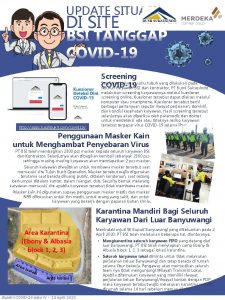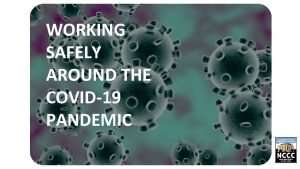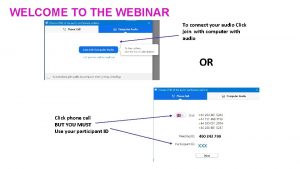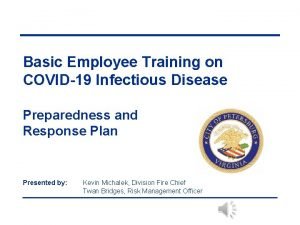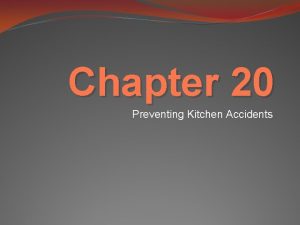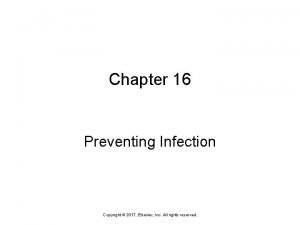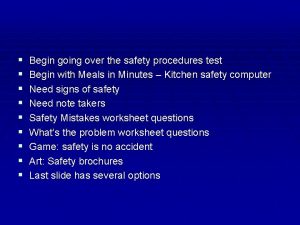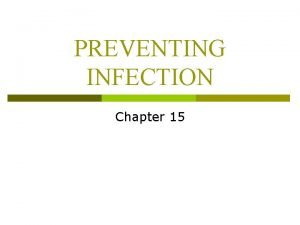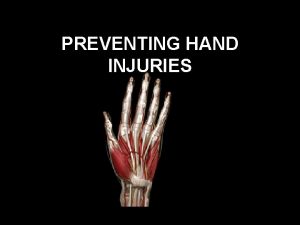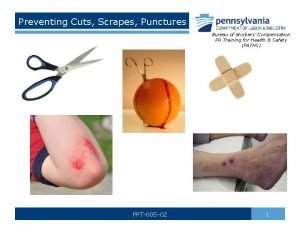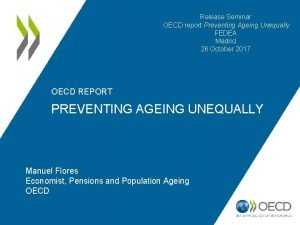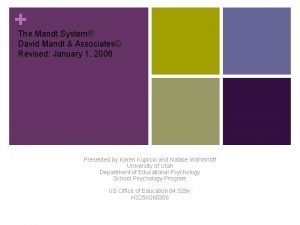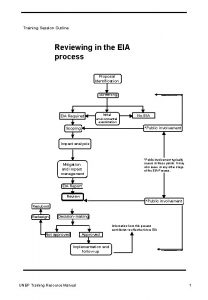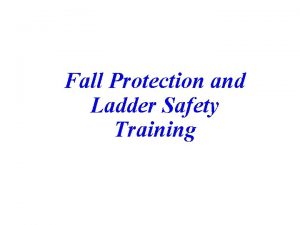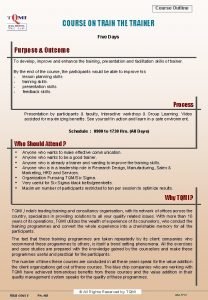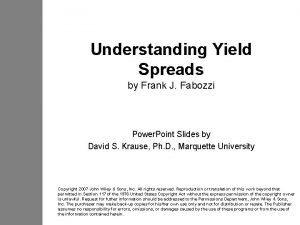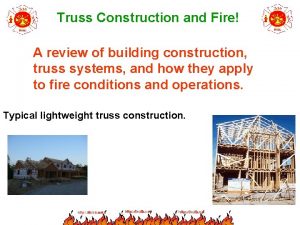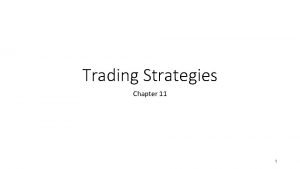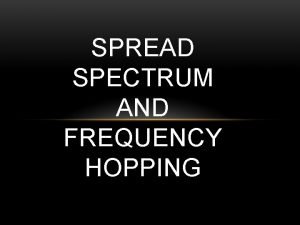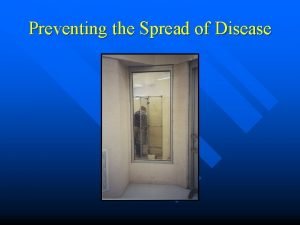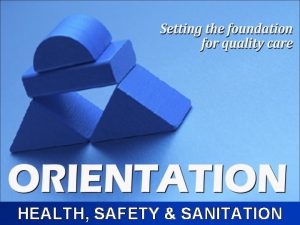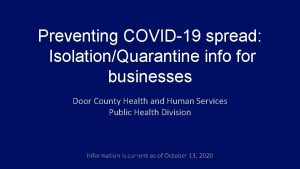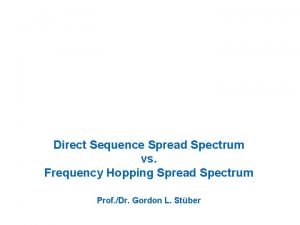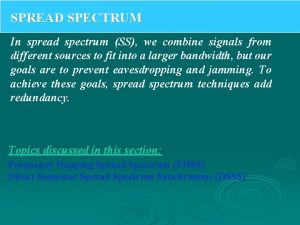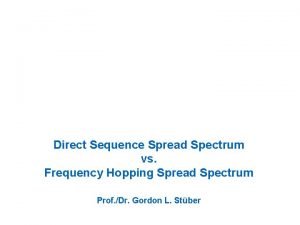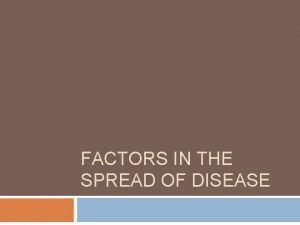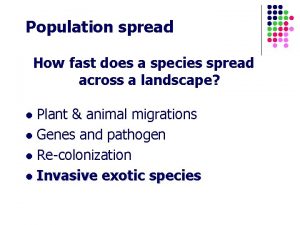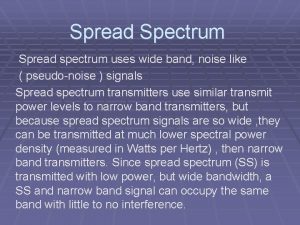COVID19 TRAINING Outline Information on COVID19 preventing spread









































- Slides: 41

COVID-19 TRAINING

Outline: Information on COVID-19, preventing spread, and who is especially vulnerable. Self-screening at home, including temperature and/or symptom checks using CDC guidelines. The importance of not coming to work if workers have symptoms such as; a cough, fever, difficulty breathing, chills, muscle pain, headache, sore throat, recent loss of taste or smell, congestion or runny nose, nausea or vomiting, or diarrhea, or if they or someone they had contact with has been diagnosed with COVID-19. To return to work after a COVID-19 diagnosis only after 10 days since symptom onset and 72 hours of no fever. When to seek medical attention. The importance of hand washing. The importance of physical distancing, both at work and off work time. Proper use of cloth face covers, including information in the CDPH guidance. Information on paid leave benefits, including the Families First Coronavirus Response Act, and workers’ compensation benefits under the Governor’s Executive Order N-62 -20 while that Order is in effect. Train any independent contractors, temporary, or contract workers in these policies and ensure they have necessary PPE. Healthy Schools Act - IPM Training for School Staff - Online Training Options

Information on COVID-19, how to prevent it from spreading, which underlying health conditions may make individuals more susceptible to contracting the virus.

What you need to know: Anyone can have mild to severe symptoms. Older adults and people who have severe underlying medical conditions like heart or lung disease or diabetes seem to be at higher risk for developing more serious complications from COVID-19 illness.

Watch for symptoms: People with COVID-19 have had a wide range of symptoms reported – ranging from mild symptoms to severe illness. Symptoms may appear 2 -14 days after exposure to the virus.

People with these symptoms may have COVID-19: Fever or chills Cough Shortness of breath or difficulty breathing Fatigue Muscle or body aches Headache New loss of taste or smell Sore throat Congestion or runny nose Nausea or vomiting Diarrhea This list does not include all possible symptoms. CDC will continue to update this list as we learn more about COVID-19.

When to Seek Emergency Medical Attention: Look for emergency warning signs* for COVID-19. If someone is showing any of these signs, seek emergency medical care immediately: Trouble breathing Persistent pain or pressure in the chest New confusion Inability to wake or stay awake Bluish lips or face *This list is not all possible symptoms. Please call your medical provider for any other symptoms that are severe or concerning to you. Call 911 or call ahead to your local emergency facility: Notify the operator that you are seeking care for someone who has or may have COVID-19.

What is the difference between Influenza (Flu) and COVID-19? Influenza (Flu) and COVID-19 are both contagious respiratory illnesses, but they are caused by different viruses. COVID-19 is caused by infection with a new coronavirus (called SARS-Co. V-2) and flu is caused by infection with influenza viruses. Because some of the symptoms of flu and COVID-19 are similar, it may be hard to tell the difference between them based on symptoms alone, and testing may be needed to help confirm a diagnosis. Flu and COVID-19 share many characteristics, but there are some key differences between the two. While more is learned every day, there is still a lot that is unknown about COVID-19 and the virus that causes it. This table compares COVID-19 and flu, given the best available information to date.

Prevent it from spreading COVID-19 is thought to spread mainly through close contact from person-toperson. Some people without symptoms may be able to spread the virus. We are still learning about how the virus spreads and the severity of illness it causes.

Person-to-person spread The virus is thought to spread mainly from person-to-person. Between people who are in close contact with one another (within about 6 feet). Through respiratory droplets produced when an infected person coughs, sneezes, or talks. These droplets can land in the mouths or noses of people who are nearby or possibly be inhaled into the lungs. COVID-19 may be spread by people who are not showing symptoms.

The virus spreads easily between people How easily a virus spreads from person-to-person can vary. Some viruses are highly contagious, like measles, while other viruses do not spread as easily. Another factor is whether the spread is sustained, which means it goes from person-to-person without stopping. The virus that causes COVID-19 is spreading very easily and sustainably between people. Information from the ongoing COVID-19 pandemic suggests that this virus is spreading more efficiently than influenza, but not as efficiently as measles, which is highly contagious. In general, the more closely a person interacts with others and the longer that interaction, the higher the risk of COVID-19 spread.

The virus may be spread in other ways It may be possible that a person can get COVID-19 by touching a surface or object that has the virus on it and then touching their own mouth, nose, or possibly their eyes. This is not thought to be the main way the virus spreads, but we are still learning more about how this virus spreads.

Spread between animals and people At this time, the risk of COVID-19 spreading from animals to people is considered to be low. Learn about COVID-19 and pets and other animals. It appears that the virus that causes COVID-19 can spread from people to animals in some situations. CDC is aware of a small number of pets worldwide, including cats and dogs, reported to be infected with the virus that causes COVID-19, mostly after close contact with people with COVID-19. Learn what you should do if you have pets.

Protect yourself and others The best way to prevent illness is to avoid being exposed to this virus. You can take steps to slow the spread. Maintain good social distance (about 6 feet). This is very important in preventing the spread of COVID-19. Wash your hands often with soap and water. If soap and water are not available, use a hand sanitizer that contains at least 60% alcohol. Routinely clean and disinfect frequently touched surfaces. Cover your mouth and nose with a cloth face covering when around others. Learn more about what you can do to protect yourself and others.

People Who Are at Increased Risk for Severe Illness: Everyone is at risk for getting COVID-19 if they are exposed to the virus. Some people are more likely than others to become severely ill, which means that they may require hospitalization, intensive care, or a ventilator to help them breathe, or they may even die. We learn more about COVID-19 every day, and as more information becomes available, CDC will continue to update and share information about risk for severe illness. Among adults, the risk for severe illness from COVID-19 increases with age, with older adults at highest risk. Severe illness means that the person with COVID-19 may require hospitalization, intensive care, or a ventilator to help them breathe, or they may even die.

Risk for Severe Illness Increases with Age As you get older, your risk for severe illness from COVID-19 increases. For example, people in their 50 s are at higher risk for severe illness than people in their 40 s. Similarly, people in their 60 s or 70 s are, in general, at higher risk for severe illness than people in their 50 s. The greatest risk for severe illness from COVID-19 is among those aged 85 or older.

Underlying Medical Conditions can also increase your risk for severe illness. By understanding the factors that put you at an increased risk, you can make decisions about what kind of precautions to take in your daily life.

People of any age with certain underlying medical conditions are at increased risk for severe illness from COVID-19: People of any age with the following conditions are at increased risk of severe illness from COVID-19: Cancer Chronic kidney disease COPD (chronic obstructive pulmonary disease) Immunocompromised state (weakened immune system) from solid organ transplant Obesity (body mass index [BMI] of 30 or higher) Serious heart conditions, such as heart failure, coronary artery disease, or cardiomyopathies Sickle cell disease Type 2 diabetes mellitus

People with the following conditions might be at an increased risk for severe illness from COVID-19: (COVID-19 is a new disease. Currently there are limited data and information about the impact of underlying medical conditions and whether they increase the risk for severe illness from COVID-19. Based on what we know at this time) Asthma (moderate-to-severe) Cerebrovascular disease (affects blood vessels and blood supply to the brain) Cystic fibrosis Hypertension or high blood pressure Immunocompromised state (weakened immune system) from blood or bone marrow transplant, immune deficiencies, HIV, use of corticosteroids, or use of other immune weakening medicines Neurologic conditions, such as dementia Liver disease Pregnancy Pulmonary fibrosis (having damaged or scarred lung tissues) Smoking Thalassemia (a type of blood disorder) Type 1 diabetes mellitus Children who have medical complexity, who have neurologic, genetic, metabolic conditions, or who have congenital heart disease might be at increased risk for severe illness from COVID-19 compared to other children

Self-screening at home, including temperature and/or symptom checks using CDC guidelines.

The importance of not coming to work: If a worker has symptoms of COVID-19 as described by the CDC, such as a fever or chills, cough, shortness of breath or difficulty breathing, fatigue, muscle or body aches, headache, new loss of taste or smell, sore throat, congestion or runny nose, nausea, vomiting, or diarrhea, OR If a worker was diagnosed with COVID-19 and has not yet been released from isolation, OR If, within the past 14 days, a worker has had contact with someone who has been diagnosed with COVID-19 and is considered potentially infectious (i. e. still on isolation).

To return to work after a worker receives a COVID-19 diagnosis only if 10 days have passed since symptoms first appeared, their symptoms have improved, and the worker has had no fevers (without the use of fever reducing medications) for the last 72 hours. A worker without symptoms who was diagnosed with COVID-19 can return to work only if 10 days have passed since the date of the first positive COVID-19 test.

To seek medical attention if their symptoms become severe, including persistent pain or pressure in the chest, confusion, or bluish lips or. Updates face. and further details are available on CDC’s webpage.

When to Seek Emergency Medical Attention: Look for emergency warning signs* for COVID-19. If someone is showing any of these signs, seek emergency medical care immediately: Trouble breathing Persistent pain or pressure in the chest New confusion Inability to wake or stay awake Bluish lips or face *This list is not all possible symptoms. Please call your medical provider for any other symptoms that are severe or concerning to you. Call 911 or call ahead to your local emergency facility: Notify the operator that you are seeking care for someone who has or may have COVID-19.

The importance of frequent handwashing with soap and water, including scrubbing with soap for 20 seconds (or using hand sanitizer with at least 60% ethanol (preferred) or 70% isopropanol (if the product is inaccessible to unsupervised children) when workers cannot get to a sink or handwashing station, per CDC guidelines).

The importance of physical/social distancing, both at work and off work time

What is Physical/Social distancing? Physical/Social distancing means keeping a safe space between yourself and other people who are not from your household. To practice physical/social distancing, stay at least 6 feet (about 2 arms’ length) from other people who are not from your household in both indoor and outdoor spaces. Physical/social distancing should be practiced in combination with other everyday preventive actions to reduce the spread of COVID-19, including wearing cloth face coverings, avoiding touching your face with unwashed hands, and frequently washing your hands with soap and water for at least 20 seconds.

Why practice physical/social distancing? COVID-19 spreads mainly among people who are in close contact (within about 6 feet) for a prolonged period. Spread happens when an infected person coughs, sneezes, or talks, and droplets from their mouth or nose are launched into the air and land in the mouths or noses of people nearby. The droplets can also be inhaled into the lungs. Recent studies indicate that people who are infected but do not have symptoms likely also play a role in the spread of COVID-19. Since people can spread the virus before they know they are sick, it is important to stay at least 6 feet away from others when possible, even if you—or they—do not have any symptoms. Physical/social distancing is especially important for people who are at higher risk for severe illness from COVID-19.

If you are sick with COVID-19, have symptoms consistent with COVID-19, or have been in close contact with someone who has COVID-19, it is important to stay home and away from other people until it is safe to be around others.

COVID-19 can live for hours or days on a surface depending on factors such as sunlight, humidity, and the type of surface. It may be possible that a person can get COVID-19 by touching a surface or object that has the virus on it and then touching their own mouth, nose, or eyes. However, this is not thought to be the main way the virus spreads. Physical/social distancing helps limit opportunities to come in contact with contaminated surfaces and infected people outside the home.

Although the risk of severe illness may be different for everyone, anyone can get and spread COVID-19. Everyone has a role to play in slowing the spread and protecting themselves, their family, and their community. In addition to practicing everyday steps to prevent COVID-19, keeping space between you and others is one of the best tools we have to avoid being exposed to this virus and slowing its spread in communities.

Tips for Physical/Social Distancing When going out in public, it is important to stay at least 6 feet away from other people and wear a cloth face covering to slow the spread of COVID-19. Consider the following tips for practicing social distancing when you decide to go out.

Know Before You Go: Before going out, know and follow the guidance from local public health authorities where you live. Prepare for Transportation: Consider social distancing options to travel safely when running errands or commuting to and from work, whether walking, bicycling, wheelchair rolling, or using public transit, rideshares, or taxis. When using public transit, try to keep at least 6 feet from other passengers or transit operators – for example, when you are waiting at a bus station or selecting seats on a bus or train. When using rideshares or taxis, avoid pooled rides where multiple passengers are picked up, and sit in the back seat in larger vehicles so you can remain at least 6 feet away from the driver. Follow these additional tips to protect yourself while using transportation.

Limit Contact When Running Errands: Only visit stores selling household essentials in person when you absolutely need to, and stay at least 6 feet away from others who are not from your household while shopping and in lines. If possible, use drive-thru, curbside pick-up, or delivery services to limit face-to-face contact with others. Maintain physical distance between yourself and delivery service providers during exchanges and wear a cloth face covering.

Choose Safe Social Activities: It is possible to stay socially connected with friends and family who don’t live in your home by calling, using video chat, or staying connected through social media. If meeting others in person (e. g. , at small outdoor gatherings, yard or driveway gathering with a small group of friends or family members), stay at least 6 feet from others who are not from your household. Follow these steps to stay safe if you will be participating in personal and social activities outside of your home.

Keep Distance at Events and Gatherings: It is safest to avoid crowded places and gatherings where it may be difficult to stay at least 6 feet away from others who are not from your household. If you are in a crowded space, try to keep 6 feet of space between yourself and others at all times, and wear a cloth face covering. Cloth face coverings are especially important in times when physical distancing is difficult. Pay attention to any physical guides, such as tape markings on floors or signs on walls, directing attendees to remain at least 6 feet apart from each other in lines or at other times. Allow other people 6 feet of space when you pass by them in both indoor and outdoor settings.

Stay Distanced While Being Active: Consider going for a walk, bike ride, or wheelchair roll in your neighborhood or in another safe location where you can maintain at least 6 feet of distance between yourself and other pedestrians and cyclists. If you decide to visit a nearby park, trail, or recreational facility, first check for closures or restrictions. If open, consider how many other people might be there and choose a location where it will be possible to keep at least 6 feet of space between yourself and other people who are not from your household.

Proper use of face coverings, including: Face coverings do not protect the wearer and are not personal protective equipment (PPE). Face coverings can help protect people near the wearer, but do not replace the need for physical distancing and frequent handwashing. Face coverings must cover the nose and mouth. Workers should wash or sanitize hands before and after using or adjusting face coverings. Avoid touching eyes, nose, and mouth. Face coverings must not be shared and should be washed or discarded after each shift.

Information contained in the CDPH Guidance for the Use of Face Coverings, which mandates the circumstances in which face coverings must be worn and the exemptions, as well as any policies, work rules, and practices the employer has adopted to ensure the use of face coverings. Training should also include the employer’s policies on how people who are exempted from wearing a face covering will be handled.

Independent Contractors Ensure any independent contractors, temporary, or contract workers at the facility are also properly trained in COVID-19 prevention policies and have necessary supplies and PPE. Discuss these responsibilities ahead of time with organizations supplying temporary and/or contract workers.

Information on paid leave benefits the worker may be entitled to receive that would make it financially easier to stay at home. See additional information on government programs supporting sick leave and worker’s compensation for COVID-19, including workers’ sick leave rights under the Families First Coronavirus Response Act and workers’ rights to workers’ compensation benefits and presumption of the work-relatedness of COVID-19 pursuant to the Governor’s Executive Order N 62 -20 while that Order is in effect.
 Http//apps.tujuhbukit.com/covid19
Http//apps.tujuhbukit.com/covid19 Do if you covid19
Do if you covid19 Covid19 athome rapid what know
Covid19 athome rapid what know What do if test positive covid19
What do if test positive covid19 Vaksin covid19
Vaksin covid19 Chapter 24 lesson 2 preventing and treating stds
Chapter 24 lesson 2 preventing and treating stds Chapter 9 lesson 2 resolving conflicts
Chapter 9 lesson 2 resolving conflicts Chapter 20 preventing kitchen accidents
Chapter 20 preventing kitchen accidents Chapter 16 preventing infection
Chapter 16 preventing infection Chapter 14:1 using body mechanics
Chapter 14:1 using body mechanics Preventing kitchen accidents worksheet
Preventing kitchen accidents worksheet Max scheler empathy theory
Max scheler empathy theory Chapter 9 resolving conflicts and preventing violence
Chapter 9 resolving conflicts and preventing violence Chapter 13:2 preventing accidents and injuries
Chapter 13:2 preventing accidents and injuries Chapter 4 preventing injuries through fitness
Chapter 4 preventing injuries through fitness Chapter 15 preventing infection
Chapter 15 preventing infection Preventing hand injuries
Preventing hand injuries Preventing cuts
Preventing cuts Preventing ageing unequally
Preventing ageing unequally Which is mainly responsible for preventing erosion
Which is mainly responsible for preventing erosion What is a quote sandwich
What is a quote sandwich Army aar questions
Army aar questions Mandt restraint holds
Mandt restraint holds Training session outline
Training session outline Training presentation outline
Training presentation outline Fall protection training outline
Fall protection training outline Customer service training program outline
Customer service training program outline Train the trainer training program outline
Train the trainer training program outline Analytical thinking training course outline
Analytical thinking training course outline Objectives for work immersion
Objectives for work immersion Background information outline
Background information outline Training is expensive without training it is more expensive
Training is expensive without training it is more expensive Metode of the job training
Metode of the job training Aggression replacement training facilitator training
Aggression replacement training facilitator training Bootstrapping spot rates
Bootstrapping spot rates Difference between fillings and spread
Difference between fillings and spread Bond swap spread
Bond swap spread Lightweight truss construction
Lightweight truss construction Bear spread using puts
Bear spread using puts Protective put
Protective put Spread of christianity in europe
Spread of christianity in europe Renaissance and rebirth
Renaissance and rebirth
